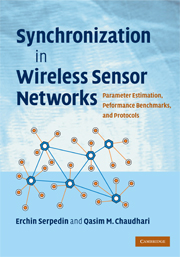 Synchronization in Wireless Sensor Networks
Synchronization in Wireless Sensor Networks Book contents
- Frontmatter
- Contents
- Preface
- 1 INTRODUCTION
- 2 SIGNAL MODELS FOR TIME SYNCHRONIZATION
- 3 TIME SYNCHRONIZATION PROTOCOLS
- 4 FUNDAMENTAL APPROACHES TO TIME SYNCHRONIZATION
- 5 MINIMUM VARIANCE UNBIASED ESTIMATION (MVUE) OF CLOCK OFFSET
- 6 CLOCK OFFSET AND SKEW ESTIMATION
- 7 COMPUTATIONALLY SIMPLIFIED SCHEMES FOR ESTIMATION OF CLOCK OFFSET AND SKEW
- 8 PAIRWISE BROADCAST SYNCHRONIZATION (PBS)
- 9 ENERGY-EFFICIENT ESTIMATION OF CLOCK OFFSET FOR INACTIVE NODES
- 10 SOME IMPROVED AND GENERALIZED ESTIMATION SCHEMES FOR CLOCK SYNCHRONIZATION OF INACTIVE NODES
- 11 ADAPTIVE MULTI-HOP TIME SYNCHRONIZATION (AMTS)
- 12 CLOCK DRIFT ESTIMATION FOR ACHIEVING LONG-TERM SYNCHRONIZATION
- 13 JOINT SYNCHRONIZATION OF CLOCK OFFSET AND SKEW IN A RECEIVER–RECEIVER PROTOCOL
- 14 ROBUST ESTIMATION OF CLOCK OFFSET
- 15 CONCLUSIONS AND FUTURE DIRECTIONS
- Acronyms
- References
- Index
12 - CLOCK DRIFT ESTIMATION FOR ACHIEVING LONG-TERM SYNCHRONIZATION
Published online by Cambridge University Press: 05 August 2012
- Frontmatter
- Contents
- Preface
- 1 INTRODUCTION
- 2 SIGNAL MODELS FOR TIME SYNCHRONIZATION
- 3 TIME SYNCHRONIZATION PROTOCOLS
- 4 FUNDAMENTAL APPROACHES TO TIME SYNCHRONIZATION
- 5 MINIMUM VARIANCE UNBIASED ESTIMATION (MVUE) OF CLOCK OFFSET
- 6 CLOCK OFFSET AND SKEW ESTIMATION
- 7 COMPUTATIONALLY SIMPLIFIED SCHEMES FOR ESTIMATION OF CLOCK OFFSET AND SKEW
- 8 PAIRWISE BROADCAST SYNCHRONIZATION (PBS)
- 9 ENERGY-EFFICIENT ESTIMATION OF CLOCK OFFSET FOR INACTIVE NODES
- 10 SOME IMPROVED AND GENERALIZED ESTIMATION SCHEMES FOR CLOCK SYNCHRONIZATION OF INACTIVE NODES
- 11 ADAPTIVE MULTI-HOP TIME SYNCHRONIZATION (AMTS)
- 12 CLOCK DRIFT ESTIMATION FOR ACHIEVING LONG-TERM SYNCHRONIZATION
- 13 JOINT SYNCHRONIZATION OF CLOCK OFFSET AND SKEW IN A RECEIVER–RECEIVER PROTOCOL
- 14 ROBUST ESTIMATION OF CLOCK OFFSET
- 15 CONCLUSIONS AND FUTURE DIRECTIONS
- Acronyms
- References
- Index
Summary
Up to now, various schemes have been proposed for estimating the clock offset and skew. However, estimating the clock of a node using a linear model is useful only for short-term applications, examples of which are object tracking and surveillance. It is not sufficient for certain applications with stringent and long-term clock synchronization requirements, such as efficient duty cycling and synchronized sampling, because they spend a lot of energy on resynchronization during a given time interval.
To elaborate on this point, consider the following examples. In FTSP the nodes in the network have to be resynchronized every minute to achieve a 90 μs synchronization error, even though it is the most efficient time synchronization protocol reported thus far and has been implemented on real testbeds with very good results. In addition, the Center for Embedded Networked Sensing (CENS) deployment at James Reserves uses RBS to synchronize the nodes after every 5 minutes and the shooter localization system implements FTSP to synchronize once every 45 seconds. Due to the difficulties associated with long-term synchronization, although RBS and FTSP estimate the clock skew alongside clock offset using linear regression, they are not adequate in practice to achieve long-term synchronization since they are confined to estimating only the first-order parameter (clock skew). Hence, to achieving the goal of long-term synchronization, a better modeling of the relationship between the clock and the reference node is required. In this chapter, this problem is targeted through extending the linear model between two clocks to a quadratic one and then the clock parameters of clock offset, skew, and drift are jointly estimated.
Information
- Type
- Chapter
- Information
- Synchronization in Wireless Sensor NetworksParameter Estimation, Performance Benchmarks, and Protocols, pp. 169 - 176Publisher: Cambridge University PressPrint publication year: 2009